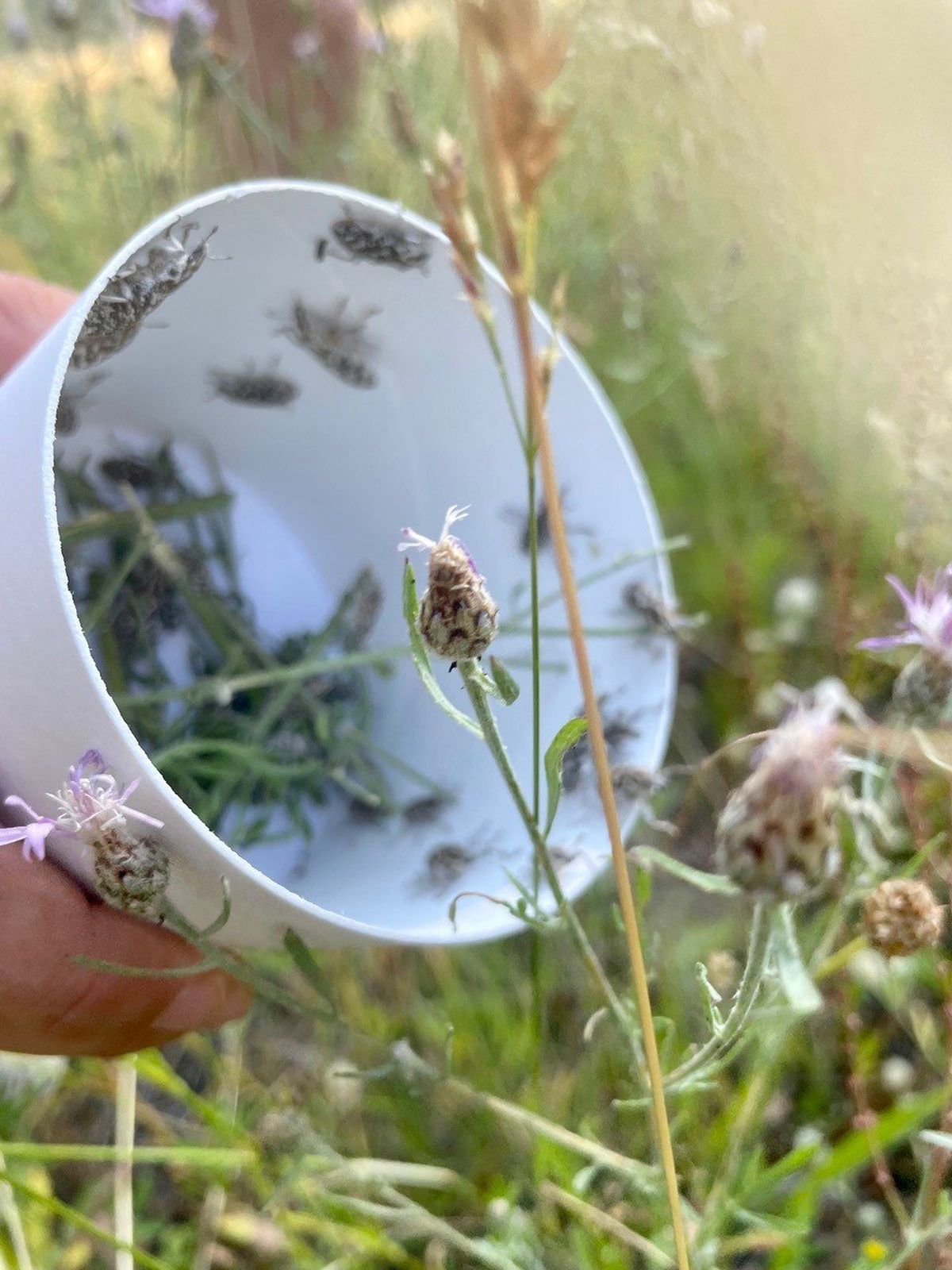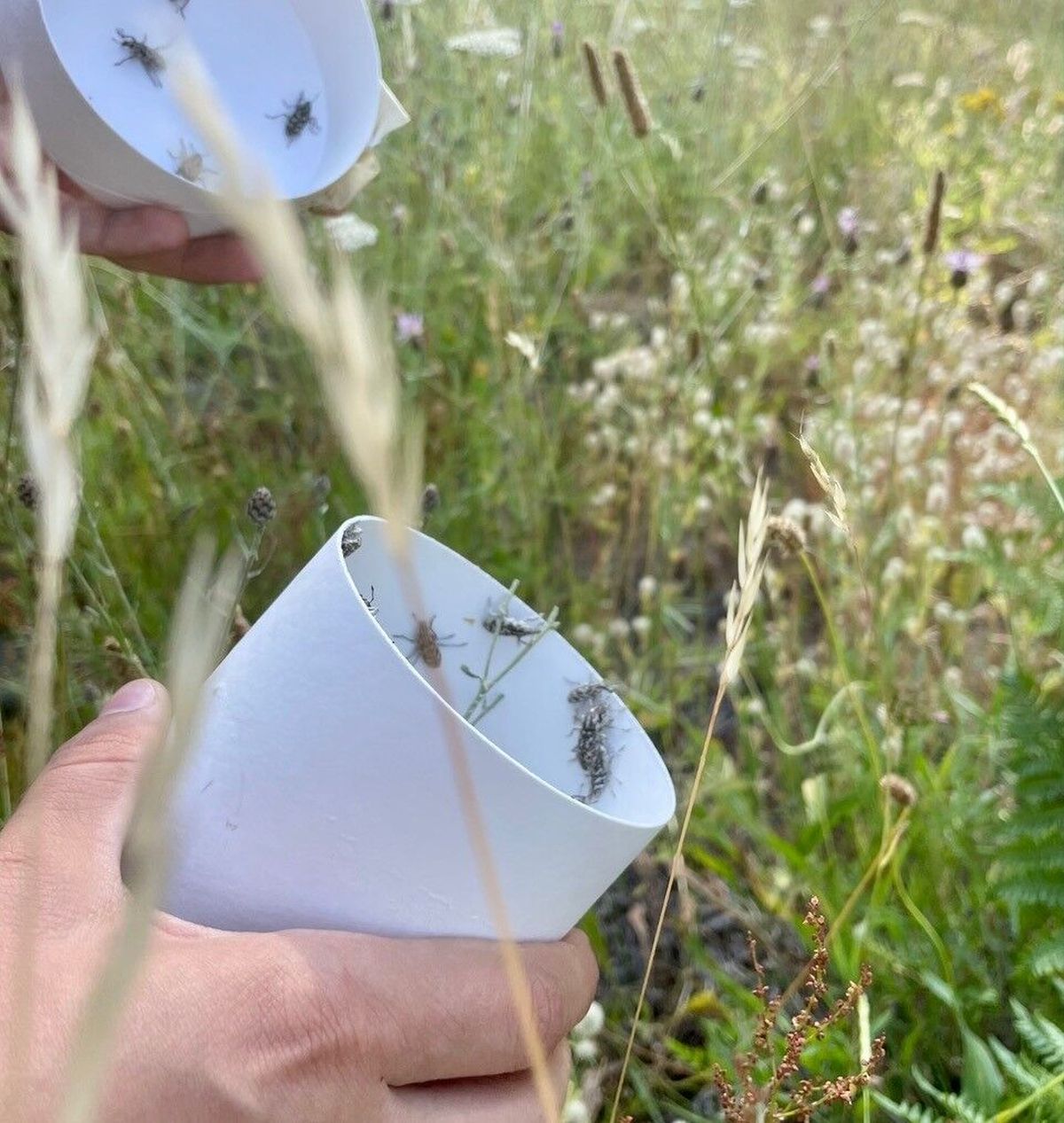Kaniksu Land Trust works to preserve environment, plan land usage in Northern Idaho
Kaniksu Land Trust staff release weevils in an effort to steward the health of the Pine Street Woods lands. (Ammi Midstokke/For The Spokesman-Review)Buy a print of this photo
Decades ago, a group of vagabond mountain bikers and wayward wanderers slowly carved a network of trails into a hillside near Dover, Idaho. For years they rode and ran and hiked their way through hundreds of acres of undeveloped forests, owned then by the Sherwood Family who were accepting enough of the trespassing.
Below the hills, the riverside town expanded along the shores of the Pend Oreille. The dreams of development became cocktail party conversation. There could be a marina, condos, summer homes, and that wide-open land to the north could become perhaps a golf course. The potential seemed limitless. After all, population growth demands progress. The people need somewhere to live.
Others saw a different impact to unbridled growth. The foothills of the Selkirks would no longer dip their forested toes into the river. The wildlife would recede into an ever-shrinking habitat. The raw land that bridged water to the mountains would be interrupted by paved roads, cosmetic landscaping, and HOAs. The people need somewhere to experience nature.
Twenty years later, on a Tuesday morning, Mark Kubiak is walking slowly up the winding trail of what is now known as Sherwood Forest, a part of the growing Syringa Trail System. Kubiak is a lean man of 70 going on 55. Evidence of his time outdoors presents as ripples of muscle under suntanned skin. He’s wearing a T-shirt from the local bike club, not a golf course.
“The grass grew high early this year,” he says as he looks up the many cleared acres of a pipeline stretching between forested slopes. “I just finished mowing it.”
When Mark and Susie Kubiak purchased the land in 2001, acquiring a conservation easement was more challenging. It wasn’t until the formation of Kaniksu Land Trust and their collaboration that they would permanently preserve the 130 acres for conservation purposes.
With that easement, the land can never be developed beyond the odd trail repair and the smattering of sculptures and art to be found hidden among the pines. Kubiak, an artist by trade, installs his work in various forms: a bust of Sam Wormington, a one-legged statue, hand-carved signs, and a small forest of blue painted pines.
Adjacent to this property is a different kind of sculpture: Recently the Meyer Family purchased 100 acres and collaborated with Pend Oreille Pedalers and a host of volunteers to build mountain bike specific trails that wind and roll and leap around the landscape.
Julie Meyer can be found on the trails any day of the week. The only thing she loves more than biking is seeing other people having fun biking. Her eyes flicker with excitement as she talks about the role of properties in conservation and community planning.
“When we plan cities and development, we must include the land in how we are thinking,” she says, seeing the land itself as a stakeholder in that process.
Now, Kaniksu Land Trust also owns an adjoining property of similar size and the trail system has been expanded to over four hundred acres that includes a ski hut, groomed trails, an education program and accessibility to everyone.
But these are prime real estate acres just a few miles or less from the cities of Sandpoint, Dover and Ponderay.
And these cities, like most of the nation, have a housing crisis.
“We have to address the housing needs of a community as well,” says Kubiak, a realist about the crisis and the socio-political challenges of conservation.
His voice is echoed by Katie Cox, the executive director of Kaniksu Land Trust.
“We want people who grew up here, who have lived and worked here their whole lives, to be able to stay here and be a part of the community,” says Cox.
She is speaking to the drastic increase in housing prices, an influx of cash from other regions, and how difficult it has become for families to afford living in the town they work in. It is a story that has been told and repeated in places like Jackson Hole, Wyoming, and Bend, Oregon.
The cost of homes in North Idaho far exceeds the median income for a family. The rental market is limited, if not barren. Working families cannot afford to live in the city and this drives them to seek lands farther and farther out of town.
Developers are buying nearby agricultural or forested lands and building to meet that demand. Currently, agricultural lands are some of the most threatened lands in the Kaniksu region. When farmlands get purchased for development, a community loses its access to locally produced food, wildlife habitat is impacted, and the lands and communities become increasingly fragmented.
“The fragmentation of open space impacts us all,” says Regan Plumb, KLT’s conservation director. “People live here for the rural landscapes. These are special places worth saving.”
As farming, particularly small farms, are challenged to stay financially viable, conservation easements for agriculture are a promising solution. Farmers have the option of selling the development rights to a land trust and receiving a cash payment, or using the extended tax incentives for up to fifteen years.
The land can then be used only for agricultural purposes, both preserving the farmlands and supporting the farmers. But this doesn’t solve the housing issue.
That is a problem KLT is working hard to solve by expanding its conservation efforts and in the development of a new Community Housing Trust (CHT). It is a solution that applies the principles of conservation regarding intentional development.
By collaboratively planning and directing human uses of land on already altered lands, or those least sensitive natural areas, communities can meet housing needs while protecting natural resources and wide open spaces. Kaniksu Land Trust has partnered with consultants, contractors and city planners to begin one of Idaho’s first Community Housing Trusts near Sandpoint.
With a CHT, the trust purchases the land, builds housing, then sells those houses while maintaining the land rights and ownership. The land rights are leased, typically for 99 years, to the homeowner. This allows the CHT to sell houses and living units at an affordable rate, which in turn allows owners to build capital over time.
Kaniksu’s CHT is using a unique funding model. While they will use traditional donations, they are working to develop an impact investment approach that supports opportunities for local funding from private citizens. Investors would then have the opportunity to contribute funds resulting ideally in the same returns and security as a traditional CD investment.
“It allows families who could otherwise not get their foot in the housing market door to actually purchase a home,” says Cox.
At a crowded table of builders and project managers, a sketch as wide as the table is spread between the people. It is a bird’s-eye view of the CHT site with small apartment buildings, a few free-standing homes, and thick borders of trees and parklike paths.
Gordon Walker, an architect legend and consultant for the project, is piling a handful of colored pencils to the side while he explains the thought process of his design.
“Here, we’ll have the parking area tucked away so it’s not disturbing the view,” Walker says.
He’s pointing out the greenery he’s drawn into the neighborhood that emulates the Dutch style of a “woonerf.” These are neighborhoods designed specifically to support shared space, low traffic, and integrated nature. It is not only a solution to affordable housing, but it brings with it the accessibility values of KLT and its commitment to the community.
These spaces are not the stereotypical packed-together low-income housing that provide an address and a stigma. The project integrates the importance of living spaces that serve the wellness of the individual with the wellness of the neighborhood, the surrounding businesses, the city in which it exists and even the broader region.
As the planning conversation unfolds, what is evident in the collaboration is the care of all those involved. They speak about creating beautiful and functional living space with the same passion and kindness as Plumb talks about preserving waterways or Kubiak talks about the importance of staying on the trails.
When these differing interests come to the same conversation, something else becomes clear: Conservation is not in conflict with development, rather, they can form an interdependent coalition as synergistic allies. This is perhaps the path to preserving nature, humanity and the planet.
Plumb’s feet crunch on the shaded gravel path as she emerges from the trees of KLT’s Pine Street Woods, the expansive land connected to the Kubiak and Meyer properties. Two interns trail behind her. She’s carrying two small, white containers that she holds up to be read.
NEZ PERCE TRIBE BIO-CONTROL CENTER, it reads. Agent collected: Cyphocleonus achates. Also known as weevils. Today, her role involves releasing a hundred weevils into a field. Weevils, a root-boring bug with a name far cuter than their appearance, function as an effective biological control agent for invasive species of knapweed.
As the little beings are released onto the soil, one can’t help but recognize how such a tiny thing can have such a broad impact.
Next year, the field will begin to look different, as native grasses have a chance to establish themselves once more, and a new spread of bright blossoms appears.
Ammi Midstokke can be contacted at ammimarie@gmail.com.

